Knights of Columbus
The Knights of Columbus (K of C) is a global Catholic fraternal service order.[1][2] Membership is composed of (and limited to) practicing Catholic men.[3] It is led by Supreme Knight Sir Carl A. Anderson.[3]
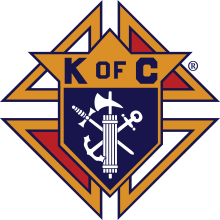 Emblem of the Knights of Columbus | |
| Abbreviation | K of C |
|---|---|
| Motto | In service to One, in service to All |
| Formation | March 29, 1882 |
| Founder | Michael J. McGivney |
| Founded at | New Haven, Connecticut |
| Type | Catholic fraternal service order |
| Headquarters | Knights of Columbus Building, New Haven, Connecticut, U.S. |
Supreme Knight | Sir Carl A. Anderson |
Supreme Chaplain | William E. Lori |
| Affiliations | |
| Website | www |
The organization was founded in 1882 as a mutual benefit society for working-class and immigrant Catholics in the United States. It has grown to support refugee relief, Catholic education, local parishes and dioceses, and global Catholic causes.[1][4][5][6] The Knights promote the Catholic view on public policy issues, including opposition to same-sex marriage,[7] abortion,[8] and birth control.[9] Between 2008 and 2012, K of C gave at least $15 million to lobbies opposed to same-sex marriage.[7]:1
The organization provides certain financial services to affiliated groups and individuals.[10] Its wholly owned insurance company, one of the largest in the world, underwrites more than two million insurance contracts, totaling more than $100 billion of life insurance in force.[11] The order also owns the Knights of Columbus Asset Advisors, a money management firm which invests in accordance with Catholic social teachings.
As of 2019, there were nearly two million members around the world.[12][13][14] Women may participate in K of C through the Columbiettes and other female auxiliaries, and boys may join the Columbian Squires. The Order comprises four different "degrees", each one of which exemplifies one of the core principles of the order.[1] There are more than 16,000 local Knights of Columbus councils around the world,[13] including over 300 on college campuses.[15][16]
History
Early years
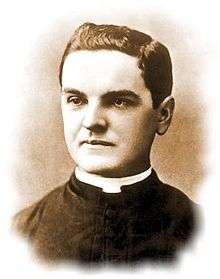
Irish-American priest Michael J. McGivney founded the Knights of Columbus in 1882 as a mutual benefit society for Catholic immigrants in New Haven, Connecticut.[17][18] [19][20]
Early 20th century
During World War I, the Knights established soldiers' welfare centers in the U.S. and abroad.[21] After the war, the Knights participated in education, occupational training, and employment programs for veterans.[22]
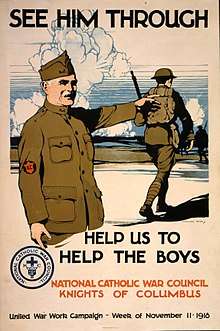
The Oregon Compulsory Education Act of 1922 would have disallowed parochial schools, including Catholic schools, in that state.[23][24][25] The Knights of Columbus challenged the law in court,[26] and, in a landmark 1925 ruling (Pierce v. Society of Sisters), the U.S. Supreme Court struck it down.[27]
In the 1920s, to combat animus targeted at racial and religious minorities, the organization published a series of three books: "Knights of Columbus Racial Contributions Series": The Gift of Black Folk, by W. E. B. Du Bois, The Jews in the Making of America by George Cohen, and The Germans in the Making of America by Frederick Schrader.[28]
During the nadir of American race relations, the Ku Klux Klan promoted a conspiracy theory claiming that Fourth Degree Knights swore an oath to exterminate Freemasons and Protestants.[29][30][31][32] The Knights began suing distributors for libel in an effort to stop this, and the KKK ended its publication of the false oath.[33]
Recent history
According to Church historian Massimo Faggioli, the Knights of Columbus are today "'an extreme version' of a post-Vatican II phenomenon, the rise of discrete lay groups that have become centers of power themselves".[6]
Degrees
The order is dedicated to the principles (Degrees) of charity, unity, fraternity, and patriotism.[34] The first ritual handbook, printed in 1885, contained only the first two Degrees teaching unity and charity. Assemblies may form color guards, which are often the most visible arm of the Knights, to attend important civic and church events.[35]
Charitable giving
The Knights of Columbus states that charity is its most important principle.[36][37] Beginning in 1897, the National Council encouraged local councils to establish funds to support members affected by the 1890s depression.[38] Aid was also dispensed to assist victims of natural and man-made disasters in the early 20th century.[39][40] Councils also offered employment agency services and provided aid to the poor and sick as well as people burdened with intellectual disability.[41][42][43] The organization has been reluctant to discuss the charitable and social causes it supports, which have tended to be more conservative than the mainstream views of Catholics in general.[44][45]
Membership
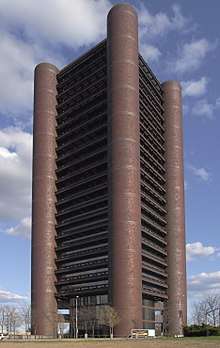
Membership is restricted to adult male Catholics.[46] As of 2018, there were 1.9 million knights.[47][48] Each member belongs to one of more than 16,000 local "councils" around the world.[13][49] The college councils program started with the chartering of University of Notre Dame Council #1477 in 1910.[50] As of 2018, there are more than 300 college councils.[15][16]
Corporate governance
The Supreme Council is the governing body of the order. It elects insurance members to serve three-year terms on a 24-member Board of Directors.[51][52] Leaders' salaries are set by the board of directors and ratified by the delegates to the Supreme Convention.[53] The seven-figure salaries of senior K of C officers have been criticized as excessive.[53][54][45]:1[6]:1 In 1969, the Knights opened a 23-story headquarters building in New Haven.[55][56]
Promotion of the Catholic faith
Efforts against religious discrimination
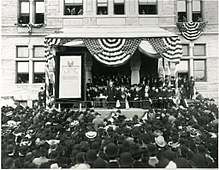
Since its earliest days, the Knights of Columbus has been a "Catholic anti-defamation society".[57] In 1914, it established a Commission on Religious Prejudices.[57] As part of the effort, the order distributed pamphlets, and lecturers toured the country speaking on how Catholics could love and be loyal to America.[58]
The creation of the 4th Degree, with its emphasis on patriotism, performed an anti-defamation function as well as asserting claims to Americanism.[59][60] In response to a defamatory "bogus oath" circulated by the KKK,[61] in 1914 the Knights set up a framework for a lecture series and educational programs to combat anti-Catholic sentiment.[62]
New evangelization
The Knights have been urged to take a prominent role in the new evangelization.[63] The CIS published a series on the new evangelization in 2011,[64] and donations to other Catholic mass communication services represent one of the Knights' major expenditures.[65] The Knights have also established councils in both secular and Catholic universities.[66]
Political activity
While the Knights were active politically from an early date, in the years following the Second Vatican Council, as the "Catholic anti-defamation character" of the order began to diminish as Catholics became more accepted, the leadership began to use its financial resources to directly influence the direction of the Church.[6] That led to the creation of a "variety of new programs reflecting the proliferation of the new social ministries of the church".[67][6]
The leadership of the order has been, at times, both liberal and conservative. Martin H. Carmody and Luke E. Hart were both political conservatives, but John J. Phelan was a Democratic politician prior to becoming Supreme Knight,[68] John Swift's "strong support for economic democracy and social-welfare legislation marks him as a fairly representative New Deal anti-communist,"[69] and Francis P. Matthews was a civil rights official and member of Harry Truman's cabinet. The current Supreme Knight, Carl A. Anderson, previously served in Ronald Reagan's White House.
While the Knights of Columbus support political awareness and activity, United States councils are prohibited by tax laws from engaging in candidate endorsement and partisan political activity due to their non-profit status.[70] The rules of the order also prohibit partisan politics in council chambers or at any events.[71] Public policy activity is limited to issue-specific campaigns, typically dealing with Catholic family and sanctity of life issues.[72][46] They state that
In addition to performing charitable works, the Knights of Columbus encourages its members to meet their responsibilities as Catholic citizens and to become active in the political life of their local communities, to vote and to speak out on the public issues of the day. ... In the political realm, this means opening our public policy efforts and deliberations to the life of Christ and the teachings of the Church. In accord with our Bishops, the Knights of Columbus has consistently maintained positions that take these concerns into account. The order supports and promotes the social doctrine of the Church, including a robust vision of religious liberty that embraces religion's proper role in the private and public spheres.[72]
The order opposed persecution of Catholics in Mexico during the Cristero War,[73] and opposed communism.[74][75] Also during the 20th century, the order established the Commission on Religious Prejudices, and the Knights of Columbus Historical Commission which combated racism.[76] It was also supportive of trade unionism, and published the works "of the broad array of intellectuals", including George Schuster, Samuel Flagg Bemis, Allan Nevins, and W. E. B. DuBois.[76]
During the Cold War, the order had a history of anti-socialist, anti-communist crusades.[77] They lobbied to add "under God" to the Pledge of Allegiance, as a religious response to Soviet atheism.[78][79] The Knights have been active opponents against the legal introduction of same-sex marriage and have been a key contributor in terms of funding to local measures.[7] The Knights have donated over US$1 million to the Susan B. Anthony Foundation and other anti-abortion and anti-contraception organizations.[6][80]
Subsidiaries
Insurance
Under the initial insurance scheme devised by founder McGivney, a deceased Knight's widow was granted a US$1,000 death benefit,[81] funded by a pro-rata contribution from the membership.[81][82] In addition, there was also a sick benefit for members who fell ill and could not work.[83]
Museum
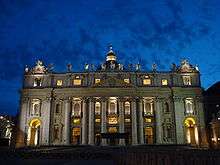
On March 10, 2001, the order opened a museum in New Haven dedicated to their history.[85][56] The 77,000 square foot building cost US$10 million to renovate.[85] It holds mosaics on loan from the Vatican and gifts from Popes, the membership application from John F. Kennedy, and a number of other items related to the history of the Knights.[85] Near the entrance is the cross held by Jesus Christ on the facade of St. Peter's Basilica[85] before undergoing a Knights-financed renovation.[84] As many as 300,000 visitors were expected per year.[85]
Knights of Columbus Asset Advisors
In 2015, the order launched Knights of Columbus Asset Advisors, a money management firm which invests money in accordance with Catholic social teaching.[10][86] The firm uses the Socially Responsible Investment Guidelines published by the United States Conference of Catholic Bishops to guide their investment decisions.[10][86] The guidelines include protecting human life, promoting human dignity, reducing arms production, pursuing economic justice, protecting the environment, and encouraging corporate responsibility.[lower-alpha 1][10] trim
In addition to the wholly owned subsidiary, it also purchased 20% of Boston Advisors, a boutique investment management firm, managing assets for institutional and high-net-worth investors.[10][88] Knights of Columbus Asset Advisors manages the fixed-income strategies for their funds while Boston Advisors sub-advises on the equity strategies.[10][88] Knights of Columbus Asset Advisors also offers model portfolio, outsourced CIO services, a bank loan strategy, and other alternative investment strategies.[10] In 2019, the Knights purchased the institutional management business of Boston Advisors.[88]
Saint John Paul II National Shrine
The order owns and operates the Saint John Paul II National Shrine in Washington D.C.[6] In 2011, the Order purchased the 130,000-square-foot John Paul II Cultural Center.[89][90][6] The mission as a cultural center ended in 2009[91] and the Knights rebranded it as a shrine to Pope John Paul II.[89][90] Soon after the pope was canonized, the United States Conference of Catholic Bishops named the building a national shrine.[91]
Each year 64,000 pilgrims visit the shrine, which features video content, interactive displays, and personal effects from John Paul.[91] There is also a first class relic of the pope's blood on display for veneration.[91] It also serves as a base for the Order in Washington, D.C.[92]
Notable Knights
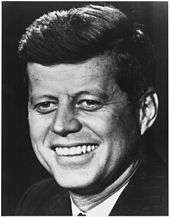
Many notable Catholic men from all over the world have been Knights of Columbus. In the United States, some of the most notable include John F. Kennedy; Ted Kennedy;[94] Al Smith;[95] Sargent Shriver;[96] Samuel Alito; John Boehner;[97] Ray Flynn;[98] Jeb Bush;[99] and Sergeant Major Daniel Daly,[100] a two-time Medal of Honor recipient.[101]
In the world of sports, Vince Lombardi, the famed former coach of the Green Bay Packers;[102] James Connolly, the first Olympic gold medal champion in modern times;[103] Floyd Patterson, former heavyweight boxing champion;[104] and baseball legend Babe Ruth[105] were all knights.
On October 15, 2006, Bishop Rafael Guizar Valencia (1878–1938) was canonized by Pope Benedict XVI in Rome. In 2000, six other Knights, who were killed in the violence following the Mexican Revolution, were declared saints by Pope John Paul II.[106]
Emblem of the order
The emblem of the order was designed by Past Supreme Knight James T. Mullen and adopted at the second Supreme Council meeting on May 12, 1883.[107] Shields used by medieval knights served as the inspiration. The emblem consists of a shield mounted on a Formée cross, which is an artistic representation of the cross of Christ. This represents the Catholic identity of the order.[108]
Mounted on the shield are three objects: the fasces; an anchor; and a dagger. In ancient Rome, the fasces was carried before magistrates as an emblem of authority. The order uses it as "symbolic of authority which must exist in any tightly-bonded and efficiently operating organization".[108] The anchor represents Christopher Columbus, patron of the order, here a symbol of the Catholic contribution to America.[109] The short sword, or dagger, was a weapon used by medieval knights. The shield as a whole, with the letters "K of C", represents "Catholic Knighthood in organized merciful action".[108]
Auxiliary groups
Women's auxiliaries
Many councils also have women's auxiliaries. At the turn of the 20th century two were formed by local councils, each taking the name Daughters of Isabella.[110][111] They expanded and issued charters to other circles but never merged. The newer organization renamed itself the Catholic Daughters of the Americas in 1921, and both have structures independent of the Knights of Columbus.[112][113] Other groups are known as the Columbiettes.[110] In the Philippines, the ladies' auxiliary is known as the Daughters of Mary Immaculate.[114]
A proposal in 1896 to establish councils for women did not pass, and was never proposed again.[115]
Columbian Squires
The Knights' official junior organization is the Columbian Squires. According to the McDonald, "The supreme purpose of the Columbian Squires is character building."[116]
It was founded in 1925 in Duluth, Minnesota, by Brother Barnabas McDonald, F.S.C..[117][118][119] The formation of new Squire Circles in the United States and Canada is discouraged as the Order desires to move youth activities from exclusive clubs into the local parish youth groups.[119]
Similar Christian organizations
The Knights of Columbus is a member of the International Alliance of Catholic Knights, which includes fifteen fraternal orders such as the Knights of Saint Columbanus in Ireland, the Knights of Saint Columba in the United Kingdom, the Knights of Peter Claver in the United States, the Knights of the Southern Cross in Australia and New Zealand, the Knights of Marshall in Ghana, the Knights of Da Gama in South Africa, and the Knights of Saint Mulumba in Nigeria.[120]
The Loyal Orange Institution, also known as the Orange Order, is a similar organization for Protestant Christians.[121][122]
See also
- Columbus Fountain
- Columbus School of Law
- Father Millet Cross
- James Cardinal Gibbons Memorial Statue
- The Knight on the Grid
- Knights of Columbus Hostel fire
- List of Knights of Columbus buildings
- List of Massachusetts State Deputies of the Knights of Columbus
- Manuscripta
- Parish Priest (book)
- Pope John Paul II Cultural Center
Notes
- The full guidelines are published on the episcopal conference's website.[87]
References
- Rundio, Steve (March 31, 2019). "Knights of Columbus conduct Exemplification Ceremony in Tomah". Tomah Journal. Retrieved November 25, 2019.
- Hubbard & Hubbard 2019, p. 75.
- "Knights of Columbus: Join us".
- Hearn 1910.
- Arce, Rose; Costello, Carol (October 22, 2012). "Election Day May Reveal Shift on Same-Sex Marriage". CNN. Turner Broadcasting System. Retrieved June 19, 2016.
- Roberts, Tom (May 15, 2017). "Knights of Columbus' Financial Forms Show Wealth, Influence". National Catholic Reporter. Retrieved January 18, 2018.
- McElwee, Jason J. (October 19, 2012). "Knights of Columbus Key Contributor Against Same-Sex Marriage". National Catholic Reporter. Kansas City, Missouri. Retrieved August 21, 2018.
- Kathryn Jean Lopez (December 9, 2019). "Kamala Harris Learns the Hard Way: Lay Off the Knights of Columbus".
- "25 Dangers of Hormonal Birth Control".
- Comtois, James (February 27, 2016). "Knights of Columbus forms money manager, targets Catholic institutional investors". Pensions and Investments. Retrieved March 6, 2018.
- "Knights of Columbus reach $100 billion in life insurance". Catholic News Agency. November 9, 2015. Retrieved January 22, 2018.
- Hubbard & Hubbard 2019, p. 76.
- Hadro, Matt (August 5, 2019). "Knights of Columbus Donated More Than $185 Million to Charity in 2018". National Catholic Register. Retrieved November 23, 2019.
- Long-Garcia, J.D. (August 13, 2019). "Knights of Columbus commit to helping asylum seekers at the southern border" (September 2, 2019). America. Retrieved November 27, 2019.
- "Knights of Columbus Scholarships Awarded in Califon". The Hunterdon County News. June 19, 2018. Retrieved November 24, 2019.
- Ash, Jim (September 14, 2018). "Knights of Columbus celebrates milestone". Main Street Journal. Retrieved November 30, 2019.
- Kauffman 1982, p. 18.
- Glenn, Brian J. "Rhetoric of Fraternalism: Its Influence on the Development of the Welfare State 1900–1935". Retrieved December 24, 2015.
- Kauffman 1982, pp. 13–14.
- Brinkley & Fenster 2006, p. 51.
- Flanagan 2017.
- Kauffman 1995.
- 268 U.S. 510 (1925)
- "Pierce v. Society of Sisters". University of Chicago Kent School of Law. Retrieved June 28, 2013.
- Kauffman 1982, p. 282.
- Kauffman 1982, p. 283.
- Alley 1999, pp. 41–44.
- Kauffman 1982, pp. 269–270.
- Kauffman 1982, p. 171.
- Fry 1922, pp. 109–116.
- Kauffman 1982, p. 176.
- Mecklin 2013.
- Kauffman 1982, p. 277.
- Knestout, Barry C. (November 30, 2019). "Knestout: Knights' generosity exemplary for all Catholics". The Roanoke Times. Retrieved December 4, 2019.
- Borowski, Dave (November 5, 2014). "Mysteries of the regalia revealed". Catholic Herald. Retrieved December 4, 2019.
- LeRoux, Kelly; Feeney, Mary K. (November 13, 2014). Nonprofit Organizations and Civil Society in the United States. Routledge. p. 50. ISBN 978-1-135-10355-2. Retrieved December 11, 2019.
- McGrath, Michael J. (January 1, 2010). Answering the Call: How God Transformed the Lives of Nineteen Catholic Deacons. Wipf and Stock Publishers. p. 39. ISBN 978-1-4982-7190-5. Retrieved December 11, 2019.
- Kauffman 1982, p. 127.
- Kauffman 1982, p. 161.
- "FIFTY YEARS OLD". The Tampa Times. March 28, 1932. p. 4. Retrieved December 2, 2019.
- Kauffman 1982, p. 428.
- Kauffman 1982, pp. 166–67.
- Kauffman 1982, p. 320.
- 3 things to know before you invest with the Knights of Columbus
- Israel, Josh (December 22, 2014). "How One Religious Organization Bankrolls America's Social Conservative Movement". ThinkProgress. Archived from the original on March 23, 2017. Retrieved January 10, 2020.
- Hopfensperger, Jean (August 9, 2019). "Knights of Columbus work to refresh image, attract younger members". Star Tribune. Retrieved December 4, 2019.
- Mares, Courtney (August 7, 2018). "Knights of Columbus pledge support for persecuted Christians". Catholic News Agency. Retrieved November 25, 2019.
- Hadro, Matt (August 7, 2019). "At Knights convention, Kendrick Castillo remembered, honored as 'a hero'". Catholic News Agency. Retrieved December 2, 2019.
- Connecticut Insurance Department 2018, p. 2.
- "Indiana bishop urges Fightin' Irish to join Knights". Catholic News Agency. January 30, 2019. Retrieved December 9, 2019.
- Kauffman 1982, pp. 375–376.
- "Knoxvillian elected to Knights' board of directors". The East Tennessee Catholic. October 2, 2013. Retrieved December 10, 2019.
- "Fraternal chief's pay questioned". Tampa Bay Times. St. Petersburg, Florida. April 4, 1992. p. 54. Retrieved December 9, 2019 – via Newspapers.com.

- The Tablet, 7 September 2019, pp. 4–5.
- Hubbard & Hubbard 2019, p. 76–77.
- Clark, Marlene (September 19, 2007). "KNIGHTS OF COLUMBUS FIND A HOME—AND KEEP IT". The Hartford Courant. Retrieved December 8, 2019.
- Kauffman 1982, p. 153.
- Kauffman 1982, p. 185.
- Salvaterra 2002.
- Kauffman 1982, pp. 138–143.
- Kauffman 1982, pp. 169–175.
- Kauffman 1982, p. 178.
- Bauman, Michelle (August 7, 2012). "Knights of Columbus called to be in front ranks of New Evangelization". Catholic News Agency. Retrieved December 15, 2019.
- "Catholic Information Service to Launch Series on the New Evangelization". www.kofc.org. November 29, 2011. Retrieved December 15, 2019.
- Roberts, Tom (May 15, 2017). "Knights of Columbus' financial forms show wealth, influence". National Catholic Reporter. Retrieved December 15, 2019.
- Wuerl, Cardinal Donald (2013). "Preface". New Evangelization: Passing on the Catholic Faith Today. Our Sunday Visitor. p. Preface. ISBN 978-1-61278-302-4. Retrieved December 15, 2019.
- Kauffman 1982.
- Kauffman 1982, p. 62.
- Kauffman 1982, p. 367.
- Caplin; Drysdale (Winter 1999). "Voter Education vs. Partisan Politicking: What a 501(c)(3) Can and Cannot Do". The Grantsmanship Center Magazine. Los Angeles. Archived from the original on April 15, 2003. Retrieved March 29, 2018.
- "Knights will keep up the fight on life, marriage issues". The Catholic Review. January 19, 2012. Retrieved December 9, 2019.
- "Catholic Citizenship And Public Policy" (PDF). Knights of Columbus. Retrieved January 18, 2018.
- Kauffman 1982, p. 302.
- Kauffman 1982, pp. 364–365.
- Larry Ceplair (2011). Anti-communism in Twentieth-Century America: A Critical History: A Critical History. ABC-CLIO. p. 114. ISBN 978-1-4408-0048-1.
- Kauffman 1982, pp. 366–367.
- Kauffman 1982, p. 366.
- Bremer, Thomas S. (2014). Formed From This Soil: An Introduction to the Diverse History of Religion in America. John Wiley & Sons. ISBN 978-1-118-32354-0.
- Greenberg, David (June 28, 2002). "The Pledge of Allegiance: Why we're not one nation 'under God'". Slate Magazine.
- How One Religious Organization Bankrolls America's Social Conservative Movement
- Kauffman 1982, p. 22.
- Kauffman 1982, pp. 36–37.
- Brinkley & Fenster 2006, p. 123.
- "The Knights of Columbus Celebrate 90 Years in Rome". Rome Reports. June 19, 2010. Archived from the original on June 22, 2010. Retrieved August 6, 2013.
- Taylor, Frances Grandy (March 20, 2001). "THE KNIGHTS OF NEW HAVEN". The Hartford Courant. Retrieved December 8, 2019.
- "Catholic Mutual Finds Created". Hartford Courant. Hartford, Connecticut. April 1, 2015. p. A8. Retrieved December 7, 2019 – via newspaper.com.

- "Socially Responsible Investment Guidelines". United States Conference of Catholic Bishops. Retrieved March 6, 2018.
- Comtois, James (October 10, 2019). "Knights of Columbus Asset Advisors acquires Boston Advisors' institutional business". Pensions & Investments. Retrieved December 2, 2019.
- Filteau, Jerry (August 3, 2011). "Knights of Columbus to purchase Pope John Paul II center". National Catholic Reporter. Retrieved December 9, 2019.
- Roberts, Tom (August 17, 2011). "Knights buy John Paul II Cultural Center". National Catholic Reporter. Retrieved December 9, 2019.
- Mauro, J-P (January 30, 2019). "Explore the legacy of St. John Paul II at his National Shrine, in DC". Alteia. Retrieved December 9, 2019.
- Boorstein, Michelle Boorstein Michelle (August 3, 2011). "Knights of Columbus to buy Pope John Paul II center". The Washington Post. Retrieved December 9, 2019.
- Singular 2005, p. 60.
- Kauffman 1982, pp. 393–394.
- Singular 2005, p. 38.
- Singular 2005, p. 94.
- "Representative John Boehner's Biography". Project Vote Smart. Retrieved July 22, 2013.
- Singular 2005, p. 114.
- Paulson, Michael (March 17, 2015). "Jeb Bush, 20 Years After Conversion, Is Guided by His Catholic Faith". The New York Times. Retrieved December 10, 2019.
- "Famous Knights of Columbus". Famous101. Retrieved June 28, 2013.
- "Iconic Artifacts". The National Museum of the Marine Corps. Retrieved June 28, 2013.
- Singular 2005, p. 64.
- Singular 2005, p. 4.
- "Floyd Patterson" (PDF). Hudson River Valley Institute at Marist College. Archived from the original (PDF) on December 30, 2011. Retrieved July 22, 2013.
- Singular 2005, p. 30.
- "1st Knight-of-Columbus-Bishop to Be Canonized". EWTN News. October 10, 2006. Retrieved June 28, 2013.
- Kauffman 1982, pp. 34–35.
- "Official Knights of Columbus Emblems and Council Jewels" (PDF). Knights of Columbus. Retrieved June 28, 2013.
- Appelbaum, Yoni (October 8, 2012). "How Columbus Day Fell Victim to Its Own Success". The Atlantic. Retrieved July 21, 2020.
- Kauffman 1982, p. 125.
- "About Us, Daughters of Isabella". Daughters of Isabella. Archived from the original on May 15, 2013. Retrieved June 28, 2013.
- "The History of the Catholic Daughters of the Americas". Catholic Daughters of America. Retrieved June 28, 2013.
- Kauffman 1982, pp. 125–126.
- "Brief History, Daughters of Mary Immaculate International". Daughters of Mary Immaculate International. Archived from the original on July 18, 2013. Retrieved June 28, 2013.
- Kauffman 1982, p. 126.
- "Church News". Valley Road Runner. February 25, 2016. Retrieved December 9, 2019.
- Djupe, Paul A. (2003). Encyclopedia of American Religion and Politics. Infobase Publishing.
- "History of the Brothers in the U.S.A. since 1845". Manhattan College. Archived from the original on March 4, 2016. Retrieved March 18, 2014.
- Delorme, Rita H. "K. of C. Squires: the name is medieval, but their goals aren't". Southern Cross. Diocese of Savannah. Retrieved December 11, 2019.
- "Member Orders". International Alliance of Catholic Knights. Archived from the original on March 14, 2007. Retrieved May 30, 2006.
- Kaufmann 2007, p. 315.
- Marchildon 2009, p. 8.
Works cited
- Alley, Robert S., ed. (1999). The Constitution & Religion: Leading Supreme Court Cases on Church and State. Amherst, New York: Prometheus Books. ISBN 978-1-57392-703-1.CS1 maint: ref=harv (link)
- Brinkley, Douglas; Fenster, Julie M. (2006). Parish Priest: Father Michael McGivney and American Catholicism. New York: William Morrow. ISBN 978-0-06-077684-8.CS1 maint: ref=harv (link)
- Dodge, William Wallace (1903). The Fraternal and Modern Banquet Orator: An Original Book of Useful Helps at the Social Session and Assembly of Fraternal Orders, College Entertainments, Social Gatherings and All Banquet Occasions. Chicago: Monarch Book Company.CS1 maint: ref=harv (link)
- Flanagan, Luke (2017). "Knights of Columbus Catholic Recreation Clubs in Great Britain, 1917–1919". In Malet, David; Anderson, Miriam J. (eds.). Transnational Actors in War and Peace: Militants, Activists, and Corporations in World Politics. Georgetown University Press. pp. 24–41. ISBN 978-1-62616-443-7.CS1 maint: ref=harv (link)
- Fry, Henry P. (1922). The Modern Ku Klux Klan. Boston: Small, Maynard & Company. Retrieved March 29, 2018.CS1 maint: ref=harv (link)
- Hearn, Edward (1910). . In Herbermann, Charles G.; Pace, Edward A.; Pallen, Condé B.; Shahan, Thomas J.; Wynne, John J. (eds.). Catholic Encyclopedia. 8. New York: Encyclopedia Press (published 1913). pp. 670–671.CS1 maint: ref=harv (link)
- Hubbard, Robert; Hubbard, Kathleen (2019). Hidden History of New Haven. Arcadia Publishing. ISBN 978-1-4671-4082-9. Retrieved November 30, 2019.CS1 maint: ref=harv (link)
- Kauffman, Christopher J. (1982). Faith and Fraternalism: The History of the Knights of Columbus, 1882–1982. Harper and Row. ISBN 978-0-06-014940-6.CS1 maint: ref=harv (link)
- ——— (1995). "Knights of Columbus". In Venzon, Anne Cipriano; Miles, Paul L. (eds.). The United States in the First World War: An Encyclopedia. New York: Garland Publishing (published 2013). pp. 321–322. ISBN 978-1-135-68453-2.CS1 maint: ref=harv (link)
- ——— (2001). Patriotism and Fraternalism in the Knights of Columbus. New York: Crossroad Publishing Company. ISBN 978-0-8245-1885-1.CS1 maint: ref=harv (link)
- Kaufmann, Eric P. (2007). The Orange Order: A Contemporary Northern Irish History. Oxford: Oxford University Press. ISBN 978-0-19-920848-7.CS1 maint: ref=harv (link)
- Koehlinger, A. (December 1, 2004). ""Let Us Live for Those Who Love Us": Faith, Family, and the Contours of Manhood among the Knights of Columbus in Late Nineteenth-Century Connecticut". Journal of Social History. 38 (2): 455–469. doi:10.1353/jsh.2004.0126.CS1 maint: ref=harv (link)
- Marchildon, Gregory P. (2009). "Introduction". In Marchildon, Gregory P. (ed.). Immigration and Settlement, 1870–1939. History of the Prairie West. 2. Regina, Saskatchewan: University of Regina Press. pp. 1–9. ISBN 978-0-88977-230-4.CS1 maint: ref=harv (link)
- McGowan, Mark G. (1999). Waning of the Green: Catholics, the Irish, and Identity in Toronto, 1887-1922. McGill–Queen's Press—MQUP. ISBN 978-0-7735-1789-9.
- Mecklin, John (2013) [1924]. The Ku Klux Klan: A Study of the American Mind. Read Books. ISBN 978-1-4733-8675-4.CS1 maint: ref=harv (link)
- Nuesse, C. Joseph (1990). The Catholic University of America: A Centennial History. Washington: Catholic University of America Press. ISBN 978-0-8132-0736-0.CS1 maint: ref=harv (link)
- Salvaterra, David L. (2002). "Review of Patriotism and Fraternalism in the Knights of Columbus: A History of the Fourth Degree by Christopher J. Kauffman". The Catholic Historical Review. 88 (1): 157–158. doi:10.1353/cat.2002.0048. ISSN 1534-0708. JSTOR 25026129.CS1 maint: ref=harv (link)
- Singular, Stephen (2005). By Their Works: Profiles of Men of Faith Who Made a Difference. New York: HarperCollins. ISBN 978-0-06-116145-2.CS1 maint: ref=harv (link)
- Sullivan, Neil (2001). The Diamond in the Bronx: Yankee Stadium and the Politics of New York. New York: Oxford University Press.CS1 maint: ref=harv (link)
Further reading
- Chisholm, Hugh, ed. (1922). . Encyclopædia Britannica. 31 (12th ed.). London: Encyclopædia Britannica Company. pp. 682–683.
- Egan, Maurice Francis; Kennedy, John James Bright (1920). The Knights of Columbus in Peace and War. 1. Knights of Columbus. ISBN 978-1-142-78398-3.CS1 maint: ref=harv (link)
- Bauernschub, John P. (1949). Fifty Years of Columbianism in Maryland. Baltimore, Maryland: Maryland State Council, Knights of Columbus.CS1 maint: ref=harv (link)
- ——— (1965). Columbianism in Maryland, 1897–1965. Baltimore, Maryland: Maryland State Council, Knights of Columbus.CS1 maint: ref=harv (link)
- Lapomarda, S.J., Vincent A. (1992). The Knights of Columbus in Massachusetts (second ed.). Norwood, Massachusetts: Knights of Columbus Massachusetts State Council.CS1 maint: ref=harv (link)
- Sweany, Mark J. (1923). Educational Work of the Knights of Columbus. Bureau of Education Bulletin. 22. Mark J. Sweaney, Director of the Knights of Columbus Educational Activities. Washington: Government Printing Office. hdl:2346/60378.CS1 maint: ref=harv (link)
External links
| Wikimedia Commons has media related to Knights of Columbus. |
